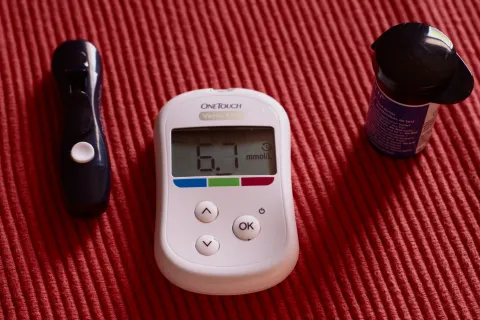ATN@Work: Personalizing hospital care for children with autism
A Q&A with the lead author of an Autism Treatment Network study that helped develop a model program for tailoring in-patient care to support kids with autism
 At Mass General Hospital for Children, Dr. Sarabeth Broder-Fingert discusses a patient’s personalized Acute Care Plan for Autism with staff nurse Karen Darocha and patient care associate Rosemond Boateng-Boadu.
At Mass General Hospital for Children, Dr. Sarabeth Broder-Fingert discusses a patient’s personalized Acute Care Plan for Autism with staff nurse Karen Darocha and patient care associate Rosemond Boateng-Boadu.
While hospital admission is difficult for anyone, autism can add the stresses of sensory issues, communication challenges, food aversions and more. In 2011, a team led by pediatrician Sarabeth Broder-Fingert, of Mass General Hospital for Children, began developing a model program to improve the hospital experience for children who have autism. To carry out the project, she enlisted a multidisciplinary team that included doctors, therapists and families at Mass General Hospital’s Lurie Center for Autism.
The Lurie Center is one of 14 North American sites in the Autism Speaks Autism Treatment Network (ATN).
In 2013, Broder-Fingert’s team tested the effectiveness of their program – which centers around a document that pediatricians ask parents fill out prior to any hospitalization. The study was made possible by a grant from the Autism Speaks ATN in its role as the federally funded Autism Intervention Research Network on Physical Health (AIR-P).
The study’s successful results appeared last month in the journal Pediatrics, as part of a special supplement on autism authored by ATN/AIR-P researchers and healthcare providers.
We asked Dr. Broder-Fingert to answer some questions about her team’s research, the great unmet need that inspired it and the model program that it produced.
Q: Our community knows firsthand how stressful and frightening a stay in the hospital can be for patients who have autism. Please tell us a little about how you became aware of their great need for a more autism-sensitive experience.
Dr. Broder-Fingert: I had an experience that opened my eyes. While I was an intern in pediatrics at Mass General Hospital for Children, I was taking care of a 10-year-old boy who had autism and was admitted for stomach pain. He was with us for about a week, and I saw that he and his family were having great difficulty. For instance, I noticed that his mother, who seemed incredibly stressed, never seemed to leave his bedside, though she clearly needed a break. She told me she was too afraid to leave because she feared a staff member might come in who didn’t understand how her son communicated and didn’t understand his many sensory issues. She feared what would happen if he couldn’t cope.
That experience made me think – “Wow, we’re not providing compassionate care for this patient and his family if we don’t know how to be sensitive to this child’s needs.”
Q: How did you approach addressing this great need?
Dr. Broder-Fingert: Right after that eye-opening experience, I thought there must be other hospitals that have developed ways to support children and families affected by autism when they come into the hospital. So I set out to find these programs and bring them back to Mass General.
To my shock, I found nothing. No programs. No tool kits. Nothing to help these special children and their families cope with the stressful hospital environment.
So I discussed the need to develop such a program with my colleagues, and we decided to bring together a wide variety of people familiar with autism.
We recruited this team from the Lurie Center for Autism, and it included doctors, nurses, occupational therapists, social workers, child life specialists – and most important of all parents.
We met about 10 times over course of 2011 to talk about the issue from different perspectives. What was it like for a child? For the family? For the hospital staff who want to support them but may not know how?
 The goals of Mass General Hospitals Acute Care Plan for AutismQ: What did you learn from parents and providers?
The goals of Mass General Hospitals Acute Care Plan for AutismQ: What did you learn from parents and providers?
Dr. Broder-Fingert: Through our meetings, we discovered what everyone agreed was the single biggest challenge: When child comes to hospital, we can note in the chart that he or she has autism, but we don’t know what that means in terms of their needs. Is the child verbal or nonverbal? Does the child have sensory issues or special dietary needs? Even if you want to be the most sensitive healthcare provider, just seeing the word “autism” in someone’s chart doesn’t help you much because autism exists across such a spectrum.
We agreed that we needed to produce a document that would allow parents to provide the hospital staff with the information they needed to support their child. This document would then go in the child’s hospital file for every member of their care team to see. One caveat, the clinicians in the group cautioned, was that if the document was more than, say three page, it might not get used.
So we needed to create a customizable document that would provide useful information on preferred communication, sensory sensitivities, safety issues, anxiety triggers and dietary needs in a short amount of space. This would become part of the child’s electronic medical record that hospital staff would see whenever the open the child’s file.
That was the beginning. We produced this document – the Autism Care Questionnaire – that became the centerpiece for our “Acute Care Plan for Autism.” (follow the text link
 The beginning of the Autism Care Questionnaire, showing the first of thirteen questions aimed at gathering information that can help meet the patient’s communication, sensory and dietary needs, reduce anxiety and increase safety.
The beginning of the Autism Care Questionnaire, showing the first of thirteen questions aimed at gathering information that can help meet the patient’s communication, sensory and dietary needs, reduce anxiety and increase safety.
Q: When and how do parents complete this document?
Dr. Broder-Fingert: We realized that the hospital admission process was already too stressful an experience. That’s not the time to ask parents to complete this document. Ideally, we want it filled out before admission.
The idea was that we would get it to parents through their children’s doctors. This involved me visiting a lot of practices both within the Lurie Center and in the surrounding community and telling doctors about it.
We appreciated that physicians have a lot of competing demands. So the only thing we asked them to do is give parents a web link to a secure online portal where parents can complete the questionnaire.
We also mailed out postcards to parents and put flyers in waiting rooms, with a focus on clinics that serve kids with autism. That included our own Lurie Center and the neurology department at our hospital.
Q: How does the completed document get into the child’s future hospital file?
Dr. Broder-Fingert: Once completed, the online form is uploaded into the child’s electronic medical record and stored as a note titled “Acute Care Plan for Autism.” Every time, a doctor, nurse or other hospital care provider opens the child’s file, they will see this note.
Q: How successful was the initial program?
Dr. Broder-Fingert: Everyone involved was so enthusiastic. Parents, hospital staff, everyone. We felt we had a model program to share with other hospitals. But knew we needed to be more rigorous in evaluating its effectiveness if we wanted other hospitals to adopt it.
That’s when we started working through the Autism Speaks ATN to complete a scientific study of its effectiveness.
Q: Why was a scientific study important?
Dr. Broder-Fingert: We designed the study to answer three crucial questions. First: Are we doing no harm? Is this safe? There was no reason to believe it wasn’t, but you can be surprised. It’s an important question to address with any intervention. Second: Are people actually using this? Third: Is it actually improving the patient experience?
Q: How did you answer these important questions?
Dr. Broder-Fingert: We knew we needed to compare the experience of patients with autism whose parents and care providers used the document to those who didn’t. We enrolled 22 children who had the Acute Care Plan and 70 who didn’t, ranging in age from 2 to 21 and across the autism spectrum in terms of severity of symptoms.
To answer the first question – Is it safe? – we looked into the hospital’s Safety Reporting System, which contains records of any safety issues that occur during a patient’s stay. The good news was that we found a trend toward relatively fewer safety reports among those who had the Acute Care Plan than among those who didn’t. So the plan passed muster on safety.
To answer the second question – Is it being used? – we looked at how often hospital staff were opening up the Acute Care Plan for Autism in each child’s file. Mass General Hospital has an audit system that records every time a patient’s electronic medical record – or any document in it – is opened. This is done for patient privacy reasons, but we were able to take advantage of it with the permission of our study participants.
This allowed us to see both how often the plan was read and see job title of the person looking at it – be that doctor, nurse, child life specialist and so one. We could see the document was being opened frequently – especially by nurses – throughout a child’s stay.
Third, we needed to know whether the plan was actually improving the patient’s hospital experience. We did so by asking all the participating parents to answer several questions, such as rating the overall stay on a scale of 1 to 10.
Almost universally, the parents whose child had an Acute Care Plan for Autism in his or her file reported being happier with hospital stay and more likely to give the hospital a higher rating than were the parents of children who did not have such a plan.
Though our study sample was relatively small – just under a hundred patients – we can say that these preliminary results signal that children and their families are having a better experience as a result of implementing this plan. It passed all three of our tests.
In addition, we invited the parents in the study to write in comments along with rating their child’s experience. The comments were very positive.
Q: What’s the next step in spreading the use of autism-specific hospital care plans?
Dr. Broder-Fingert: Our goal is to share this program with other hospitals to improve the in-patient experience of children who have autism everywhere. Of course, every hospital a little different, so we want a straight-forward template that hospitals can modify to fit their situation. For example, some hospitals have multiple entrances and they may want to be able to direct the family to the one that’s easiest for their child – perhaps the one that’s quieter or avoids fluorescent lighting.
Q: What about a hospital care plan for adults who have autism?
Dr. Broder-Fingert: We are already working collaboratively with Mass General Hospital to expand this to the adult side. We are trying to enroll adult patients on the autism spectrum. We are asking them to fill out the plan, while we also do trainings with the hospital staff.
These trainings can be a challenge because, generally adult hospitals are much larger than children’s hospitals. Here at Mass General, for example, we have about a hundred nurses on the pediatric side compared to at least a thousand nurses on the adult side.
Q: So it’s not just a questionnaire for patients and parents, this program also involves training hospital staff?
Dr. Broder-Fingert: Yes, we need to train staff to both look for the document in a patient’s file and respond appropriately to the information in it.
Q: Since Pediatrics published the special ATN/AIR-P supplement that included your study, have you gotten interest from other hospitals?
Dr. Broder-Fingert: Yes, we’ve had multiple hospitals reach out and say they’re interested. They very much want to better serve patients with autism as best they can. They just need help to know what to do. The challenge as always is to get funding to move this work forward with trainings. The good news is that once this program is set up, it’s self-sustaining.








